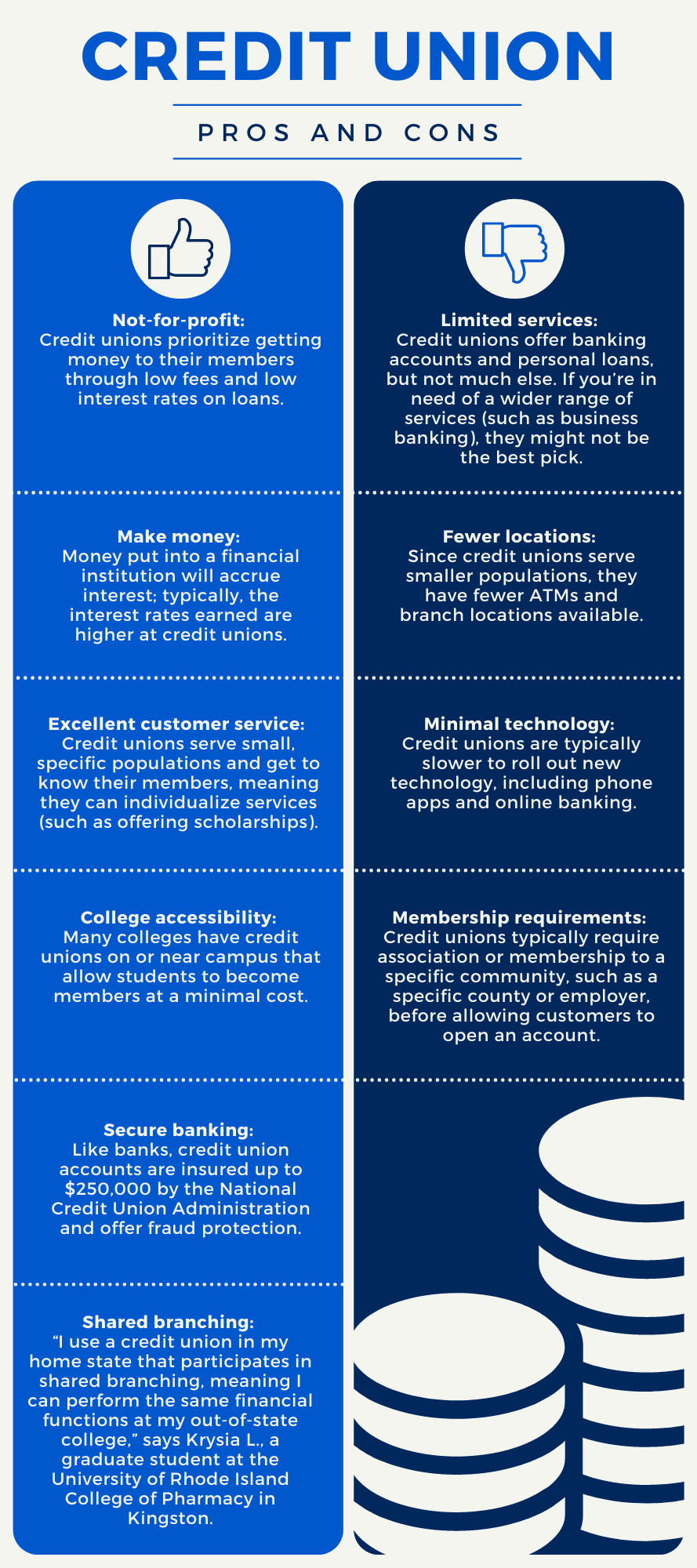Wyoming Credit Union: Trusted Financial Solutions for each Demand
Wyoming Credit Union: Trusted Financial Solutions for each Demand
Blog Article
The Ultimate Overview to Understanding Credit Rating Unions
:max_bytes(150000):strip_icc()/6-benefits-of-using-a-credit-union.aspx_final-6e501699186e429ab6458d9e36ebe4a1.jpg)
Credit history unions stand as unique monetary entities, rooted in principles of shared support and member-driven operations. However, past their fundamental values, recognizing the complex workings of cooperative credit union includes a deeper expedition. Deciphering the intricacies of subscription eligibility, the advancement of services used, and the unique benefits they bring requires a thorough evaluation. As we browse through the ins and outs of cooperative credit union, an insightful trip awaits to shed light on these member-focused organizations and how they vary from traditional financial institutions.
What Are Lending Institution?
Cooperative credit union are member-owned economic institutions that use a series of banking solutions to their members. Unlike standard financial institutions, cooperative credit union run as not-for-profit organizations, implying their key emphasis is on serving their members instead than optimizing profits. Members of a lending institution generally share a common bond, such as benefiting the same employer, belonging to the very same neighborhood, or belonging to the very same company.
One of the crucial advantages of credit rating unions is that they often use higher rates of interest on savings accounts and lower rates of interest on fundings contrasted to financial institutions. Federal Credit Union. This is due to the fact that cooperative credit union are structured to profit their participants straight, allowing them to pass on their incomes in the kind of far better prices and fewer fees. Furthermore, credit rating unions are understood for their customized customer care, as they focus on building connections with their participants to recognize their special economic needs and goals
History and Advancement of Credit History Unions
The roots of member-owned economic cooperatives, understood today as credit scores unions, trace back to a time when communities sought options to conventional banking institutions. The principle of lending institution originated in the 19th century in Europe, with Friedrich Wilhelm Raiffeisen typically credited as the pioneer of the participating banking movement. Raiffeisen started the initial identified lending institution in Germany in the mid-1800s, highlighting community assistance and self-help principles.
The evolution of credit rating unions continued in The United States and copyright, where Alphonse Desjardins developed the initial cooperative credit union in copyright in 1900. Quickly after, in 1909, the very first united state credit history union was formed in New Hampshire by a group of Franco-American immigrants. These early cooperative credit union operated on the essential concepts of common assistance, autonomous control, and participant possession.
In time, lending institution have expanded in popularity worldwide due to their not-for-profit structure, focus on offering participants, and providing affordable economic services and products. Today, lending institution play an essential role in the monetary sector, offering easily accessible and community-oriented banking choices for individuals and organizations alike.

Membership and Qualification Criteria
Subscription at a credit score union is commonly limited to people satisfying particular eligibility standards based on the establishment's starting principles and regulatory needs. Some credit rating unions may just serve people that live or function in a particular area, while others might be customized to workers of a specific firm or participants of a certain organization.
In addition, credit unions are structured as not-for-profit organizations, suggesting that their key objective is to serve their members rather than produce earnings for shareholders. This concentrate on participant solution usually equates into more individualized focus, lower costs, and competitive rates of interest on financial savings and finances accounts. By satisfying the eligibility standards and ending up being a member of a lending institution, people can access a variety of economic services and products tailored to their particular demands.
Services and Products Used
One of the essential elements that sets credit report unions apart is the varied range of financial solutions and items they provide to their members. Credit rating unions generally provide traditional financial solutions such as cost savings and checking accounts, Read Full Report loans, and credit rating cards.
In addition, credit rating unions frequently give hassle-free online and mobile banking options for participants to quickly manage their funds. They might use advantages such as shared branching, enabling participants to access their accounts at various other lending institution across the nation. Some cooperative credit union likewise provide insurance policy items like home, life, and automobile insurance coverage to help members shield their assets and liked ones.

Advantages of Financial With Lending Institution
When thinking about financial establishments, checking out the advantages of financial with credit score unions exposes unique advantages for members looking for customized solution and competitive prices. Unlike large financial institutions, credit report unions are member-owned and focus on building strong relationships with their members. Overall, financial with a credit score union can offer an extra individualized, affordable, and member-centric economic experience.
Conclusion
In final thought, credit history unions stand out as member-owned their explanation economic establishments that focus on offering their members over optimizing revenues. With origins dating back to 19th century Europe, credit score unions adhere to concepts of shared help and participant ownership.
Credit history unions are member-owned monetary institutions that offer an array of financial services to their members. The principle of credit unions stem in the 19th century in Europe, with Friedrich Wilhelm Raiffeisen usually attributed as the pioneer of the cooperative banking activity.The advancement of debt unions proceeded in North America, where Alphonse Desjardins developed the first credit scores union in copyright in 1900. Credit history unions normally give standard financial solutions such as cost savings and inspecting accounts, fundings, and credit score cards.When considering here economic organizations, exploring the advantages of financial with credit unions reveals one-of-a-kind advantages for participants seeking individualized service and affordable rates.
Report this page